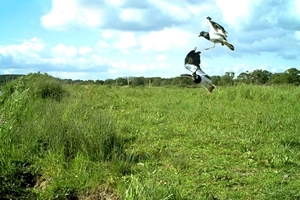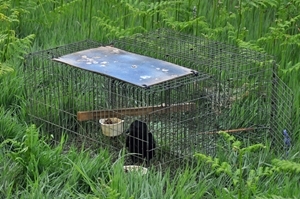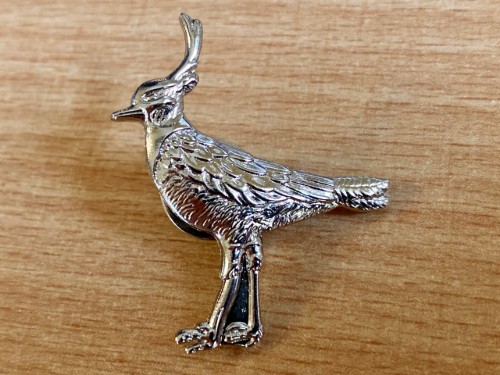Key points
- This study looked at the effect of fox and crow control on breeding success and population trends for lapwing on 11 RSPB nature reserves in lowland wet grassland areas.
- Predator control doubled breeding success on sites where there was a high background level of predators.
- Predator control had no effect on breeding success for sites where the background level of predators was low to start with.
- Understanding local predator densities and the predators responsible for low productivity are both important when making decisions about the value of predator management for breeding lapwing recovery.
Background
 Recent decades have seen steep declines in the number of breeding waders on wet grassland sites in the UK. These are thought to be driven mainly by a decline in the availability and quality of breeding habitat because of changes in grassland management, predominantly drainage and increased use of fertilisers.
Recent decades have seen steep declines in the number of breeding waders on wet grassland sites in the UK. These are thought to be driven mainly by a decline in the availability and quality of breeding habitat because of changes in grassland management, predominantly drainage and increased use of fertilisers.
Scientific research has helped us to understand the habitat needs of breeding waders, and this knowledge has been used to develop agri-environment scheme support to help improve breeding habitat. The benefits of this have been variable, but recoveries have been seen at some sites.
Over the period of this decline, the number of wader predators has risen. Ground-nesting waders now breed in fewer places, in smaller numbers, which leaves them more vulnerable to the effects of predation. For lapwing, research has highlighted the importance of breeding density – isolated nests are more likely to suffer predation than those that are part of a group, nesting in higher densities.
We know that the long-term decline of lapwings in Britain is caused by low breeding success, rather than poor adult survival. Research has shown that low nest and/or chick survival, in some cases because of high predation, may be limiting wader populations, causing further declines and local extinctions.
Although the benefits of predation control have been well studied in gamebirds, the effects on other species were relatively unknown before this study. It considered the effect of fox and crow control on breeding lapwing, both being previously identified as important predators of wader nests and chicks.
What they did
11 lowland wet grassland sites, spread through lowland England and Wales, were selected and studied for eight years. Sites differed in the suite and density of predators. Predator control of foxes and crows was carried out for four years at five of these sites, followed by four years of no predator control. The other six sites had four years without predator control, then it was implemented for the subsequent four years.
Predator control was also carried out at a further two sites for the entire eight years of study. Foxes were controlled from the beginning of the year to the end of June, with increased activity at the beginning of the breeding season (February to April). Carrion crows were trapped from March until June. The number of foxes and crows at sites with control were monitored throughout the study to assess how effectively predator control reduced fox and crow abundance.
Habitat management to benefit lapwing was carried out at all sites and remained the same throughout.
Lapwing were monitored to understand the impact of control on nesting success and chick survival. Nests were considered successful if at least one egg hatched. Chick survival was monitored using radio tags at seven of the sites throughout the fledging period. Lapwing nest survival was monitored on another 11 sites without experimental predator control to give further information on the background levels of predation and annual fluctuations in nest survival.
What they found
 The effect of predator control on local fox density varied from site to site, with an overall reduction of 40% when all sites were pooled. There was a gradually increasing effect of predator control over time – proportionally fewer foxes were seen at sites that had predator control in place for four years compared to in their first year of control.
The effect of predator control on local fox density varied from site to site, with an overall reduction of 40% when all sites were pooled. There was a gradually increasing effect of predator control over time – proportionally fewer foxes were seen at sites that had predator control in place for four years compared to in their first year of control.
The effect of crow control was more consistent, with on average more than half of territorial crows (those that are likely to be breeding birds) removed, however total crow numbers did not change. This is probably because the number of non-territorial birds rises in the area when territorial ones are removed.
In areas where there were naturally few predators (particularly foxes) present, the effect of predator control was limited, but at sites where the background density of foxes was higher, predator control increased nesting success. When the background density of predators at a site was included in the analysis, predator control increased lapwing nest survival.
No impact of control on chick survival was found from radio-tracking studies carried out at six sites, though the sites included in this part of the study had low baseline predator densities. Analysis of data from six sites where radio-tracking was not conducted, but that had generally higher predator densities, found the proportion of adults accompanied by chicks doubled in years with predator control. This effect was consistent between all sites.
What does this mean?
This study found that where predator densities are higher, reducing their numbers with predator control was beneficial to lapwing breeding success, but where predators were scarcer, it did not. This is important because it highlights the need to understand the local predator population before embarking on predator control strategies at a particular site to benefit lapwings. As with game management, predator control for breeding wader recovery must be conducted alongside good habitat management, particularly on sites where high levels of predation have been identified.
Read the original paper
Bolton, M., Tyler, G., Smith, K. and Bamford, R. (2007). The impact of predator control on lapwing Vanellus vanellus breeding success on wet grassland nature reserves. Journal of Applied Ecology, 44: 534-544.

Get your GWCT Lapwing Badge for £9.99
£5 from the sale of each badge goes directly to our Wader Tracking Appeal
You can support our biggest tracking project yet and help curlew, lapwing and woodcock with our brand new lapwing pin badge. £5 from the sale of each badge goes toward this vital project. Badge measures approx 3cm x 3.5cm.
View Badge >
or
Buy Now - £9.99 >
100% Secure. All Credit & Debit cards, PayPal, Apple Pay and Google Pay accepted.
